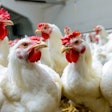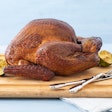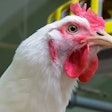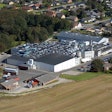.jpg?auto=format%2Ccompress&q=70&w=400)
Providing feed to suckling piglets is getting more attention for various reasons. Litter sizes are increasing while average birth weight is decreasing, so additional feed intake is needed to obtain the maximum growth of piglets. It has been calculated that the milk production of modern sows is not sufficient for maximum growth of their litters for days eight to ten of lactation onward (Brooks and Tsourgiannis, 2003).
Secondly, the need to reduce antibiotics emphasizes the need for optimum nutrition and farm management to ensure a healthy environment for piglets to grow.
To reduce the mortality rate within litters, it is important to get more piglets to eat. A highly digestible meal containing sufficient dairy ingredients will improve not only the number of eaters, but also lowers the risk of bowel disorders.
Return on investment
Large litter sizes often coincide with a high mortality rate because of low average birth weights (Table 1). For the pig producer, every additional piglet per farrow is an increased return on investment. It is therefore essential to offer feed that stimulates intake and results in optimal growth. A higher intake of a dairy meal ensures a higher slaughter weight and, at the end, a better return on investment.
The problem with vegetable proteins
Traditionally, piglets are fed before weaning with a pre-starter meal of pellets containing approximately 15-20 percent dairy ingredients. About four to five weeks after weaning the piglets are fed a weaner and starter feed based on 5-10 percent dairy. We can conclude that all these feeds are low in dairy and high in vegetable protein.
However, in newborn piglets, the enzymatic system needed to digest vegetable protein is not yet fully developed. Offering a weaner diet high in vegetable proteins can increase the growth of pathogenic bacteria, which enlarges the risk of fecal disorders and, ultimately, may cause mortality. Vegetable proteins negatively affect intake while dairy proteins are digested much better. We may therefore conclude that optimal nutrition contains sufficient dairy ingredients.
Maintain optimal growth
Intake of additional dairy-based feed during the suckling period will facilitate the change from liquid milk to solid feed after weaning. It is known that a low feed intake post-weaning is the main cause of damage to the intestines that occurs in early weaned piglets (Kelly et al., 1991). This damage can lead to post-weaning health disorders like diarrhea.
Intake of feed before weaning has been shown to improve the adaptation to the weaning process, and to result in a higher performance in the immediate post-weaning period and in the total rearing period (Bruininx et al., 2002).
Eating habits within litters
Within litters, there are piglets that have a good intake of pre-starter diets, while other piglets hardly eat any of the diet (Bruininx et al., 2002). Bruininx et al. classified eaters and non-eaters within litters by using the feces marker technique on three different days during the suckling period, when piglets were provided a pelleted pre-starter diet.
They noticed that approximately 26 percent of the piglets could not be classified as eaters on any of the three sampling days, indicating that these piglets did not eat of the commonly fed pelleted pre-starter diet.
Approximately 50 percent of the piglets were classified as eaters at one or two sampling days. This means that only 24 percent of the piglets were classified as eaters on all three days and could be determined as good eaters.
Therefore, it is not only important to increase the total feed intake of litters during the suckling period, but also to increase the number of eating piglets within litters.
Feed presentation and composition
Diet presentation and diet composition are important factors to increase the number of eaters within litters. During the first weeks of life, the digestive tract of the piglets is adapted to digest nutrients like lactose, fat, and the milk proteins casein and whey (King and Pluske, 2003). Therefore, pre-starter diets preferably are composed of these nutrients, and highly digestible feedstuffs should be used. To obtain a significant effect on growth rate, pre-starter diets should be highly concentrated considering the relatively low feed intake of the piglets.
Also, the presentation of the diet can influence the feed intake of the piglets. Mash diets can be easily sampled by piglets and are more easily ingested than (hard) pellets.
Trials by Schothorst Feed Research
In May 2011, Schothorst Feed Research tested two feeds: a commercial pelleted pre-starter diet and a new dairy-based “ready-to-use” meal. Each diet was fed to a minimum of 30 litters from day five after birth until weaning at approximately 21-28 days. Litter sizes were between 11 and 14 piglets at day five after birth.
Growth rate was calculated for the total suckling period based on birth weight and weaning weight. In total, 68 litters entered the trials. The results are shown in Table 2.
More piglets eating
Prior to the 2011 tests, Schothorst Feed Research demonstrated that the capacity to digest vegetable feedstuffs was limited in newly weaned piglets, a group that is comparable to young piglets. Tokach et al. (1995) demonstrated, as well, that piglets fed dairy feedstuffs were gaining more weight in the first week after weaning than when fed vegetable feedstuffs. Araujo et al. (2010) had similar conclusions.
Comparable field trials, performed in 17 different countries, also confirmed the findings of Schothorst Feed Research. In these trials, the “ready-to-use” dairy meal resulted not only in more piglets eating, but also in a considerable lower mortality rate and a higher slaughter weight than the control group.
Conclusion
Changing demands in farm management as well as larger litters and smaller piglets force farmers to pay extra attention to feed requirements. It is important to provide a highly digestible additional feed in the pre-weaning phase to not only improve de-adaptation to the feed given in the weaning period, but also to get more piglets to reach this weaning period.
To reduce the mortality rate within litters, it is important to get more piglets to eat. A highly digestible meal containing sufficient dairy ingredients will improve not only the number of eaters, but also lowers the risk of bowel disorders.

















